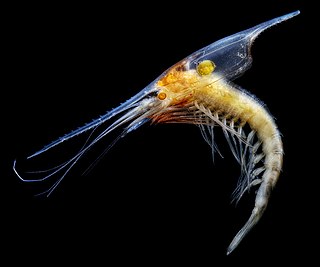
The Diogenidae are a family of hermit crabs, sometimes known as "left-handed hermit crabs" because in contrast to most other hermit crabs, its left chela (claw) is enlarged instead of the right. It comprises 429 extant species, and a further 46 extinct species, making it the second-largest family of marine hermit crabs, after the Paguridae.

Petrolisthes is a genus of marine porcelain crabs, containing these extant species:

The western terrestrial garter snake is a western North American species of colubrid snake. At least five subspecies are currently recognized.

Goniodoris is a genus of sea slugs, specifically dorid nudibranchs, marine gastropod molluscs in the family Goniodorididae.

Seguenzia elegans is a species of sea snail, a marine gastropod mollusk in the family Seguenziidae.
Fossarus is a genus of sea snails, marine gastropod mollusks in the family Planaxidae.
Cuapetes agag is a species of shrimp found in New Caledonia, Melanesia, Queensland, and the Red Sea. It was first named by Kemp in 1922.
Cuapetes amymone is a species of shrimp found in the Pacific and Indian Oceans. It was first named by Johannes Govertus de Man in 1902.
Cuapetes andamanensis is a species of shrimp found in the Pacific and Indian Oceans. It was first named by Kemp in 1922.

Sagartia elegans, the elegant anemone, is a species of sea anemone in the family Sagartiidae. It is found in coastal areas of northwest Europe at depths down to 50 metres.

Cuapetes is a genus of shrimp in the family Palaemonidae, comprising the following species:

Mathilda is a genus of sea snails, marine gastropod mollusks in the family Mathildidae.

Gnathophausia is a genus of lophogastrid crustacean. There are 10 species recognized in the genus Gnathophausia:
Steindachnerina elegans is a fish species in the genus Steindachnerina found in rivers in Bahia and Minas Gerais, Brazil.

Apophysomyces variabilis is an emerging fungal pathogen that can cause serious and sometimes fatal infection in humans. This fungus is a soil-dwelling saprobe with tropical to subtropical distribution. It is a zygomycete that causes mucormycosis, an infection in humans brought about by fungi in the order Mucorales. Infectious cases have been reported globally in locations including the Americas, Southeast Asia, India, and Australia. Apophysomyces variabilis infections are not transmissible from person to person.
C. elegans most commonly refers to the model round worm Caenorhabditis elegans. It may also refer to any of the species below. They are listed, first in taxonomic order and, second, alphabetically.
Hemisphaeranthos is an extinct genus of sea cucumbers. The following species are recognised in the genus Hemisphaeranthos:
Corbitella elegans is a species of glass sponges (Hexactinellids) belonging to the family Euplectellidae. It is found in the Banda Sea in the Maluku Islands of Indonesia.

Sepia elegans, the elegant cuttlefish, is a species of cuttlefish in the family Sepiidae from the eastern Atlantic Ocean and the Mediterranean Sea. It is an important species for fisheries in some parts of the Mediterranean where its population may have suffered from overfishing.










